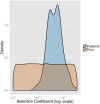Population genetic analysis of the DARC locus (Duffy) reveals adaptation from standing variation associated with malaria resistance in humans
- PMID: 28282382
- PMCID: PMC5365118
- DOI: 10.1371/journal.pgen.1006560
Population genetic analysis of the DARC locus (Duffy) reveals adaptation from standing variation associated with malaria resistance in humans
Abstract
The human DARC (Duffy antigen receptor for chemokines) gene encodes a membrane-bound chemokine receptor crucial for the infection of red blood cells by Plasmodium vivax, a major causative agent of malaria. Of the three major allelic classes segregating in human populations, the FY*O allele has been shown to protect against P. vivax infection and is at near fixation in sub-Saharan Africa, while FY*B and FY*A are common in Europe and Asia, respectively. Due to the combination of strong geographic differentiation and association with malaria resistance, DARC is considered a canonical example of positive selection in humans. Despite this, details of the timing and mode of selection at DARC remain poorly understood. Here, we use sequencing data from over 1,000 individuals in twenty-one human populations, as well as ancient human genomes, to perform a fine-scale investigation of the evolutionary history of DARC. We estimate the time to most recent common ancestor (TMRCA) of the most common FY*O haplotype to be 42 kya (95% CI: 34-49 kya). We infer the FY*O null mutation swept to fixation in Africa from standing variation with very low initial frequency (0.1%) and a selection coefficient of 0.043 (95% CI:0.011-0.18), which is among the strongest estimated in the human genome. We estimate the TMRCA of the FY*A mutation in non-Africans to be 57 kya (95% CI: 48-65 kya) and infer that, prior to the sweep of FY*O, all three alleles were segregating in Africa, as highly diverged populations from Asia and ≠Khomani San hunter-gatherers share the same FY*A haplotypes. We test multiple models of admixture that may account for this observation and reject recent Asian or European admixture as the cause.
Conflict of interest statement
I have read the journal’s policy and the authors of this manuscript have the following competing interests: CDB is on the scientific advisory boards (SABs) of Ancestry.com, Personalis, Liberty Biosecurity, BigDataBio, Digitalis Ventures and Etalon DX. He is also a founder and chair of the SAB of IdentifyGenomics. None of these entities played a role in the design, interpretation, or presentation of these results.
Figures



References
-
- Haldane J. Disease and evolution. Ric Sci Suppl. 1949;19:68–76.
-
- Cutbush M, Mollison PL, Parkin DM. A new human blood group. Nature. 1950;165:188–189. 10.1038/165188b0 - DOI
MeSH terms
Substances
Grants and funding
LinkOut - more resources
Full Text Sources
Other Literature Sources

